The following article looks at teaching foundation phase players awareness on the field of play. U8 players learn awareness on the ball by lifting their head, U10 players learn awareness receiving a ball by checking their shoulders and U12 players learn full field awareness on and off the ball.
"Football is played with the head. The feet are just the tools." - Andrea Pirlo
Teaching players to be aware is an important skill. Look at the greatest players over the past few decades and they all share this ability, both with and without the ball. Decision-making without lifting the head will never be as strong as it needs to be. If players only look at the ball, they won't know WHEN and WHERE to pass, run, dribble or shoot.
Teaching awareness should take place as young as U8. It is important that we as coaches understand where players are in their technical, tactical, physical and social development to maximise their understanding and improvements in that area.
Awareness at U8
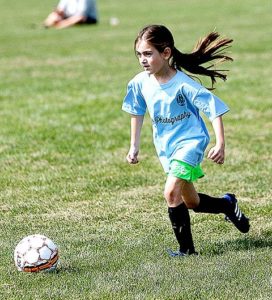
Technical - U8 players need to learn how to manipulate the ball with all parts of both of their feet. This is to aid them in all 1v1 situations - whether a player is in front of them, behind them or to the side.
Tactical - Shielding the ball from an opponent is the key skill here. Teaching players how to keep the ball on the safe side of their body, when and where to turn and giving themselves extra time to make a decision and lift their head.
Physical - Players start learning how to regulate their speed. This goes for with and without the ball.
Social - My friend and I. U8's often have 1 best friend in their social situations. In soccer this also true, meaning 2v1/2v2 activities should form the basis of group activities. They are more likely to pass if they feel they will get the ball back. Less players on the field also give them more time to look away from the ball.
Game - Through the Gates
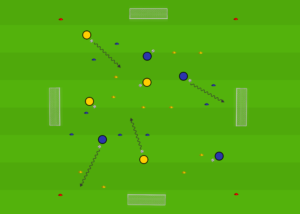
Set Up - Set up a 20x20 area with any number of 2 yard gates inside. Each player is given a ball. Players have 60 seconds to dribble through as many gates as possible. Progress to players partnering up and racing against their partners.
Progression
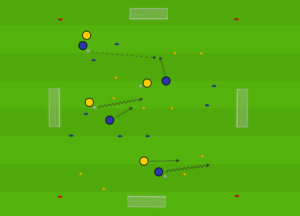
Players are in teams. One team has a ball each. Players without a ball can steal from an opponent or provide support for their team mate to pass to. Every gate dribbled through is worth 1 point.
Awareness Coaching Points
Look forward to see where you are dribbling
Look side to side to avoid other players
Look 2 gates ahead to know where you are going next
Observe the position of the defender to determine the best decision - pass or dribble
Observe to position of the defender to know the best way to turn
Why it Works
Players get to take lots of touches on the ball. Constant changes of speed and direction allow them to use all different parts of their feet to control the ball. Players will need to observe the positions of teh defender to protect the ball as needed and keep it on the safe side as much as possible. Allwoing a pass keeps decision-making simple - keep the ball or pass to my partner.
Awareness at U10

Technical - U10's main technical focus should be receiving the ball to feet with multiple part of their feet - inside, outside, laces and sole. This goes for balls on the floor and in the air.
Tactical - Providing appropriate support for the player on the ball, giving them at least 3 passing options - left, right and in front.
Physical - Incorporating strectches and dynamic movements into warm ups to allow players to maintain maximum flexibility.
Social - Small group formation. Children tend to socialise in groups of 4. 3v1/3v2/4v1/4v2/5v3 activities can start taking place.
Game - Transition Game
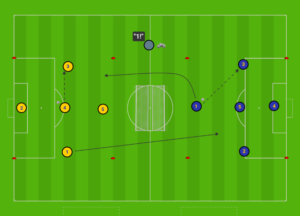
Set up two 20x20 playing areas, with a third 20x20 space in between. Have 2 mini goals, back to back, in the central space. 2 equal teams, with players of each team numbered from 1-5 (or relevant number). Players pass the ball in their groups. Coach calls out a number, for example "1!" Number 1 on each team runs across to the other teams playing area and attempts to kick the ball out. Points awarded for consecutive passes and the team who keeps their ball the longest.
Progression
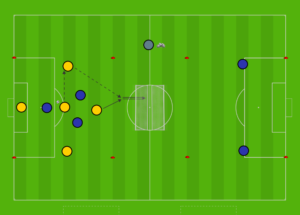
One team has a ball. One defender enters to apply pressure. With every 5/6 seconds of possession, an additional defender supports them. If the team in possession are able to keep the ball until 3/4 defenders are in their playing area, they try to release a player into the scoring zone for a first time finish.
Awareness Coaching Points
Check your shoulders when the ball is heading towards you to see position of defenders
Check your shoulders when the ball is heading towards you to see what space is available
Check your shoulders when the ball is heading towards you to see who is available for the next pass
Check your shoulders after passing to observe the next space to move into
Why it Works
Players will constantly be receiving the ball to feet. This encourages them to lift their head and check their shoulders so that they can take their first touch away from pressure. Working as a small group is necessary to achieve success, with players having to observe defenders position to create the correct supporting angle. Players will constantly be opening and closing their hips - dynamic movements that work their hip aductor and groin flexibility.
Awareness at U12

Technical - U12's should start looking at their weight of pass, esecially when playing the ball into space. Accuracy should also be considered.
Tactical - Clever, timed movement, with a big focus on forward runs off the ball. Players need to start considering the offside line when making a run forward.
Physical - Upper body control. In early years, use of the head and chest can be intimidating. With growth spurts occuring at U12 and more balls being played aerially, players need to become comfortable with this.
Social - 2 groups working together. From a team perspective, 2 units working to have success - for example the midfield and attack.
Game - Killer Pass Game
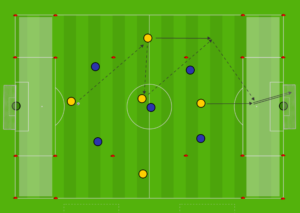
Set Up - Set up a field with 2 end zones. Split the field into 3 channels, including the end zones. Players can score by playing a through pass into the end zone for a team mate to run onto and score. The throug ball must be played diagonally. For example, if in one of the wide channels, the ball is played into the central section of the end zone. If in the central channel, the ball must be played into one of the wide sections of the end zone. If central, the finsih must be first time. If wide, the receiving player gets 2 touches.
Progression

If the ball is played into the wide section of the end zone, the ball must be crossed first time for a second player to finish first time in the central section.
Awareness Coaching Points
Observe the player on the ball to make sure they are facing forward to make the killer pass
Observe the defenders position to see if there is a gap that allows the killer pass to be made
Look across the line of cones so that you can time your run
Look at the goal while running into the endzone to make your decision on where to place the ball
Why it Works
The killer pass requires the correct weight and accuracy for the players to have success, especially when defenders are allowed to recover. Clever, timed movement is required to beat the offside line. Players must be looking across the field to time their run, as well as looking forward at the goal to make their decision when they get to the ball. A lofted killer pass encourages players to head at goal or take the ball on their chest. The midfield and attack must work together to achieve success.

